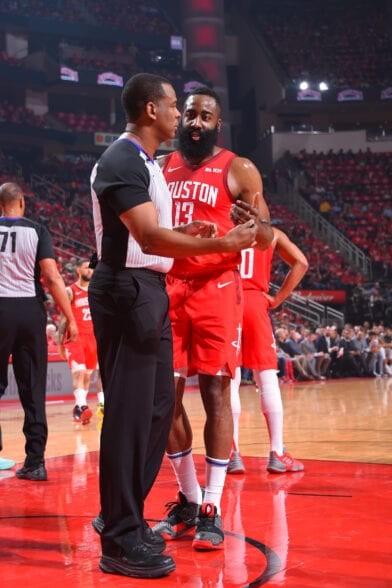Are you curious about why it sometimes seems like NBA players get away with traveling? SIXT.VN is here to unravel this complex rule, explaining its intricacies and how it impacts the game, especially for travelers visiting Vietnam and wanting to understand the local sports culture. Discover our services for seamless travel experiences, including airport transfers, hotel bookings, and guided tours, making your trip as smooth as an NBA fast break! Enjoy the beauty of Vietnam with SIXT.VN’s travel guide.
1. What is Traveling in Basketball? A Deep Dive into the NBA Rule
Traveling in basketball is a violation that occurs when a player moves their established pivot foot illegally. Essentially, after a player stops dribbling, they can only move one foot while keeping the other planted, which is the pivot foot. Lifting the pivot foot before dribbling or passing/shooting is considered traveling.
Traveling is one of the most fundamental rules in basketball. According to the NBA rule book, a player can move one foot while holding the ball, but the pivot foot must remain in contact with the ground. This rule prevents players from gaining an unfair advantage by running with the ball.
1.1. Defining the Pivot Foot: The Foundation of Legal Movement
The pivot foot is the foot a player establishes as their point of balance after receiving the ball. It’s crucial in determining whether a player is traveling. Understanding the pivot foot is key to understanding the traveling rule.
1.2. What Constitutes a Travel? Common Scenarios
A travel occurs when a player:
- Lifts their pivot foot and puts it down again before dribbling.
- Jumps off their pivot foot and lands without releasing the ball.
- Moves their pivot foot excessively.
- Falls to the ground while holding the ball without maintaining a pivot foot.
1.3. The “Gather Step”: A Modern Interpretation
The “gather step” is a more recent interpretation of the traveling rule, allowing players to take an extra step after gaining control of the ball while moving. This has added more complexity to the rule.
 James Harden in action, his signature step-back move often debated for possible traveling violations, highlighting the need for precise officiating.
James Harden in action, his signature step-back move often debated for possible traveling violations, highlighting the need for precise officiating.
2. Why Doesn’t the NBA Call Every Travel? The Referee’s Perspective
The NBA doesn’t call every travel due to the speed of the game and the subjective nature of the rule. Referees prioritize making calls that significantly impact the game, and minor travels may be overlooked. Let’s explore why:
2.1. The Speed and Flow of the Game
The NBA is known for its fast-paced, high-energy action. Referees must make split-second decisions, and calling every marginal travel would disrupt the game’s flow and entertainment value. The fast-paced nature of the game makes it challenging to catch every infraction.
2.2. Prioritizing Impactful Calls
Referees focus on calls that directly affect scoring opportunities or create a significant advantage for one team. Minor travels that don’t lead to a clear advantage may be let go.
According to a study by the NBA Referee Operations, officials aim to make the most impactful calls to maintain game integrity.
2.3. The Subjectivity of the Rule
The traveling rule is somewhat subjective, and different referees may interpret it differently. This can lead to inconsistency in calls, making it seem like some travels are ignored. The subjectivity inherent in the rule can lead to varied interpretations.
2.4. The Difficulty of Seeing Every Angle in Real-Time
Even with multiple referees on the court, it’s impossible to see every angle of every play in real-time. Some travels may simply be missed due to obstructed views or the speed of the action.
3. How Does the NBA Train Referees to Spot Traveling?
The NBA invests heavily in training referees to accurately identify traveling violations. This includes reviewing game footage, practicing on-court scenarios, and staying updated on rule interpretations. Continuous training ensures better consistency.
3.1. Film Study and Review
Referees regularly review game footage to analyze their calls and identify areas for improvement. This helps them develop a better understanding of the traveling rule and how it applies in various situations.
3.2. On-Court Practice and Drills
Referees participate in on-court drills to simulate game scenarios and practice making quick decisions. These drills help them improve their reaction time and accuracy in calling travels.
3.3. Staying Updated on Rule Interpretations
The NBA regularly updates its rule interpretations and provides referees with detailed explanations. This ensures that referees are consistently applying the rules in the way the league intends.
According to NBA Head of Referee Development and Training Monty McCutchen, continuous education is key to consistent officiating.
3.4. Feedback and Evaluation
Referees receive feedback from supervisors and peers on their performance. This feedback helps them identify areas where they can improve and ensures that they are held accountable for their calls.
4. Signature Moves and Traveling: The James Harden Debate
Players like James Harden have popularized moves that push the boundaries of the traveling rule, leading to debates among fans and analysts. His step-back jumper is a prime example of a move that often looks like a travel but is often deemed legal.
4.1. The Step-Back Jumper: Legal or Illegal?
Harden’s step-back jumper involves taking a step backward after gathering the ball, creating space for a shot. While it may appear to be a travel, the NBA has generally ruled it legal as long as he doesn’t move his pivot foot illegally. The legality often depends on precise footwork and timing.
4.2. How Players Push the Boundaries of the Rule
Players are constantly innovating and finding new ways to exploit the rules. Some players may intentionally push the boundaries of the traveling rule to gain a competitive advantage, making it harder for referees to make accurate calls. The creativity of players often tests the limits of the rule.
4.3. The NBA’s Stance on Innovative Moves
The NBA generally allows innovative moves as long as they don’t violate the core principles of the traveling rule. However, the league may step in and clarify the rule if a particular move becomes too controversial or gives players an unfair advantage. The NBA aims to balance innovation with fairness.
5. How Has the Traveling Rule Evolved Over Time?
The traveling rule has evolved significantly since the early days of basketball. Changes have been made to accommodate the changing styles of play and to address specific issues that have arisen over time. Understanding its evolution provides context.
5.1. Early Interpretations of the Rule
In the early days of basketball, the traveling rule was interpreted more strictly. Players were often called for traveling for even minor movements of their pivot foot. Early interpretations were more rigid.
5.2. Adjustments to Accommodate Modern Play
As the game evolved, the NBA made adjustments to the traveling rule to accommodate the faster pace and more athletic players. The introduction of the “gather step” is one example of this. Adjustments have made the game more fluid.
5.3. The Impact of the “Gather Step”
The “gather step” has had a significant impact on the game, allowing players to take an extra step after gaining control of the ball. This has led to more dynamic offensive plays and has made it harder for referees to call travels consistently. The “gather step” has added complexity.
6. What Happens When a Travel is Called? Penalties and Consequences
When a travel is called, the opposing team gains possession of the ball. The ball is inbounded from the sideline at the spot nearest to where the violation occurred. Here’s a closer look:
6.1. Turnover and Change of Possession
The most immediate consequence of a traveling violation is a turnover, meaning the other team gets the ball. This can disrupt a team’s momentum and scoring opportunities. Turnovers can shift game dynamics.
6.2. Inbounding the Ball
After a travel is called, the opposing team gets to inbound the ball from the sideline, close to where the travel happened. This can give them a strategic advantage to start their offensive play. Strategic inbounds can lead to scoring.
6.3. Impact on Game Momentum
Traveling calls can significantly affect the flow of a game. A timely travel call can halt a team’s scoring run or give the opposing team a chance to catch up. Momentum shifts can change the course of a game.
7. Common Misconceptions About Traveling in the NBA
Many fans have misconceptions about the traveling rule in the NBA. Understanding these misconceptions can help you appreciate the complexities of the rule and how it’s enforced. Let’s clear up some confusion.
7.1. “Any Movement of the Pivot Foot is a Travel”
This is a common misconception. Players can move their pivot foot as long as they don’t lift it completely off the ground before dribbling or passing/shooting. Minor adjustments are allowed.
7.2. “The NBA Doesn’t Care About Traveling”
While it may seem like the NBA doesn’t call many travels, the league does take the rule seriously and invests in training referees to enforce it accurately. The NBA values fair play.
7.3. “All Step-Back Jumpers are Travels”
As mentioned earlier, step-back jumpers are generally legal as long as the player doesn’t move their pivot foot illegally. The legality depends on footwork.
8. How Does the NBA Compare to Other Leagues in Enforcing Traveling?
The NBA’s enforcement of the traveling rule differs from other basketball leagues around the world. Some leagues may have stricter interpretations of the rule, while others may be more lenient. Different leagues, different rules.
8.1. FIBA Rules vs. NBA Rules
FIBA (International Basketball Federation) rules differ slightly from NBA rules regarding traveling. FIBA rules tend to be more strict, and referees may call travels more frequently. FIBA rules are often stricter.
8.2. College Basketball Rules
College basketball rules are similar to NBA rules, but there may be some differences in interpretation. College referees may be more likely to call travels in certain situations. College refs have their own style.
8.3. International Perspectives on Traveling
Basketball fans and analysts from around the world have different perspectives on the traveling rule. Some believe the NBA is too lenient, while others appreciate the league’s emphasis on flow and entertainment. Global views vary.
9. The Role of Technology in Travel Calls: Replay and Review
Technology plays an increasingly important role in helping referees make accurate travel calls. Replay review allows officials to examine questionable plays in slow motion and from multiple angles, ensuring the correct call is made. Tech aids accuracy.
9.1. How Replay Review Works
When a travel call is questionable, referees can use replay review to examine the play. They can watch the play in slow motion and from different angles to determine whether a violation occurred. Replay offers clarity.
9.2. The Impact of Technology on Accuracy
Technology has significantly improved the accuracy of travel calls in the NBA. Replay review allows referees to correct mistakes and ensure that the correct call is made, even in difficult situations. Accuracy improves with tech.
9.3. Limitations of Replay Review
While replay review is helpful, it’s not perfect. Some plays are still too close to call, even with the benefit of slow motion and multiple angles. Additionally, replay review can disrupt the flow of the game and take up valuable time. Replay isn’t always definitive.
10. What is the Future of the Traveling Rule in the NBA?
The traveling rule is likely to continue evolving as the game changes. The NBA may consider making further adjustments to the rule to address specific issues or to accommodate new styles of play. Evolution is inevitable.
10.1. Potential Rule Changes
The NBA could potentially make changes to the traveling rule to clarify certain aspects or to address specific issues. For example, the league could consider further refining the definition of the “gather step.” Refinements are possible.
10.2. The Role of Player Development
Player development will also play a role in the future of the traveling rule. As players become more skilled and athletic, they may find new ways to push the boundaries of the rule, requiring referees to adapt and adjust their approach. Skills will influence the rule.
10.3. Balancing Tradition and Innovation
The NBA will need to balance tradition and innovation as it considers changes to the traveling rule. The league will want to maintain the integrity of the game while also allowing for creativity and excitement. Balancing act required.
11. FAQs About Traveling in the NBA
Let’s tackle some frequently asked questions about traveling in the NBA.
11.1. What exactly is a pivot foot?
A pivot foot is the foot that a player establishes as their point of balance after receiving the ball. It’s the foot that must remain in contact with the ground while the player moves the other foot. It’s your anchor.
11.2. Can a player lift their pivot foot to pass or shoot?
Yes, a player can lift their pivot foot to pass or shoot, but they must release the ball before the pivot foot returns to the ground. Timing is key.
11.3. Is the “gather step” legal in the NBA?
Yes, the “gather step” is legal in the NBA. It allows players to take an extra step after gaining control of the ball while moving. It adds a step.
11.4. How do referees determine if a player has traveled?
Referees look for specific cues, such as whether the player has lifted their pivot foot before dribbling or whether they have moved their pivot foot excessively. Cues are crucial.
11.5. Why do some travels go uncalled?
Some travels go uncalled due to the speed of the game, the subjectivity of the rule, and the prioritization of impactful calls. Speed and subjectivity play a role.
11.6. Can replay review overturn a travel call?
Yes, replay review can be used to overturn a travel call if there is clear and conclusive evidence that the call was incorrect. Replay can correct errors.
11.7. How has the traveling rule changed over the years?
The traveling rule has evolved to accommodate the changing styles of play and to address specific issues that have arisen over time. It’s an evolving rule.
11.8. Is traveling enforced differently in the NBA compared to other leagues?
Yes, traveling is enforced differently in the NBA compared to other leagues. Some leagues may have stricter interpretations of the rule. Enforcement varies.
11.9. What are some common misconceptions about traveling?
Common misconceptions include the belief that any movement of the pivot foot is a travel and that the NBA doesn’t care about traveling. Misconceptions abound.
11.10. What is the future of the traveling rule in the NBA?
The traveling rule is likely to continue evolving as the game changes. The NBA may consider making further adjustments to the rule to address specific issues or to accommodate new styles of play. The future is uncertain.
12. Explore Vietnam with SIXT.VN: Your Ultimate Travel Partner
Now that you understand the intricacies of NBA traveling rules, why not explore the beauty of Vietnam with SIXT.VN? We offer a range of services designed to make your trip seamless and unforgettable. From convenient airport transfers to comfortable hotel bookings and guided tours, we’ve got you covered.
12.1. Airport Transfers: Start Your Trip Stress-Free
Arrive in Vietnam with ease by booking our reliable airport transfer service. Our professional drivers will greet you at the airport and transport you to your hotel in comfort, allowing you to relax and start your vacation on the right foot. Kick off your trip smoothly.
12.2. Hotel Bookings: Find Your Perfect Stay
Discover the best accommodations in Vietnam with our extensive hotel booking options. Whether you’re looking for a luxurious resort or a budget-friendly guesthouse, we can help you find the perfect place to stay. Find your home away from home.
12.3. Guided Tours: Discover Vietnam’s Hidden Gems
Explore Vietnam’s rich culture and stunning landscapes with our guided tours. Our experienced guides will take you to the most popular attractions and hidden gems, providing you with insider knowledge and unforgettable experiences. Uncover Vietnam’s treasures.
12.4. Why Choose SIXT.VN?
- Convenience: Book all your travel needs in one place.
- Reliability: Trust our professional and experienced team.
- Affordability: Enjoy competitive prices and great value.
- Customer Support: Get assistance whenever you need it.
12.5. Ready to Explore?
Don’t let planning your trip to Vietnam be a travel violation! Let SIXT.VN handle all the details. Contact us today to start planning your dream vacation and experience the best of Vietnam.
Visit SIXT.VN to explore our travel guide.
Address: 260 Cau Giay, Hanoi, Vietnam
Hotline/Whatsapp: +84 986 244 358
Website: SIXT.VN




